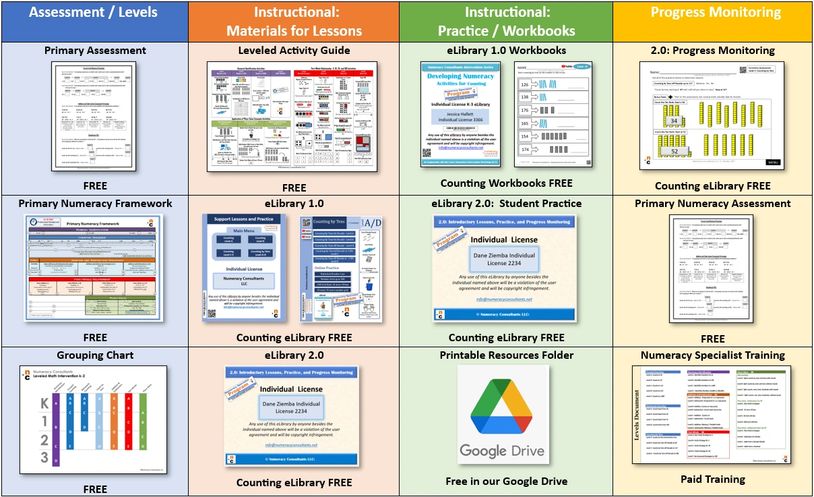Math Intervention Curriculum (Free)

The Primary Numeracy Assessment System (Free) is a comprehensive math intervention curriculum and instructional approach created from the most current research on effective strategies for building foundational numeracy. It includes free diagnostic assessments, intervention frameworks, leveled student activities, lesson plans, workbooks, curriculum maps, and more. Educators can access a free online training webinar to learn how to implement the full system with confidence. Optional supplemental lesson libraries are also available for purchase. To access the training and explore the free assessment tools and curriculum resources, click the link below.
Universal Screening Assessment Tool
Universal Screening Assessment Tool
Universal Screening Assessment Tool

The Primary Numeracy Assessment is a standards-based criterion-referenced assessment designed for students in grades K-3. The assessment aligns with US state standards. It does much more than just measure a student's ability to do computation. The assessment measures two types of skills: rote basic skills like counting, numeral identification, and place value, as well as how a student solves problems by assessing their mathematical reasoning skills. This assessment system is free and part of the Primary Numeracy Intervention Program. For training on how to administer this assessment and utilize the other components of the program, please view the free Primary Numeracy Program Webinar/Training.
Progress Monitoring and Tracking Data
Universal Screening Assessment Tool
Universal Screening Assessment Tool

Once the Primary Numeracy Assessment is administerd, its outcomes are promptly documented onto the 'Student Progress Monitoring' sheet, where the scores for each skill serve as the foundational data reflecting students' abilities. The assessment covers critical developmental areas such as counting , numeral identification, place value, and addition and subtraction strategies. All curriculum decisions will stem from this vital information.
The progress monitoring sheet stands out as the optimal resource for recording classroom interventions or accommodations, particularly for students requiring special education support.
Data Informed Instructional Decisions
Universal Screening Assessment Tool
Teacher Guide and Leveled Lesson Plans

Once the data from the Primary Numeracy Assessment is recorded, the plotting of skills on the Primary Numeracy Framework is conducted. The framework provides vertical and horizontal alignment of essential standards in grades K-3.
This curriculum resource enables teachers to visually identify their students' strengths and weaknesses. Consequently, teachers can sort and specifically target their instruction towards the critical skills that are lacking.
The Framework acts as a map so teachers can make informed instructional decisions for their students.
Teacher Guide and Leveled Lesson Plans
Targeted Instruction: Leveled Activities
Teacher Guide and Leveled Lesson Plans

The Guided Math Lesson Plan provides teachers with a versatile tool to tailor lesson content to the unique requirements of individual students or small groups. This comprehensive plan simplifies the process of monitoring student progress and growth, ensuring educators can easily track the development of each learner. Utilizing the Leveled Activities Guide, teachers can design targeted lesson plans that address varying skill levels and learning styles, fostering a supportive and enriching mathematical learning environment.
Targeted Instruction: Leveled Activities
Targeted Instruction: Leveled Activities
Targeted Instruction: Leveled Activities

The Leveled Activities Teachers Guide follows the research-based CRA instructional model. This model scaffolds concepts from concrete to representational to abstract by employing a variety of methods, strategies, and materials. These intervention strategies ensure that teachers are employing best practices within their math intervention curriculum."
Targeted Intervention and Reassessment
Targeted Instruction: Leveled Activities
Targeted Instruction: Leveled Activities

The final step is to instruct and then reassess as needed. As a teacher observes growth in each student, they can re-assess at any time to continue documenting their progress and introducing new concepts.
*The Multiplicative Thinking Assessment (3-5) follows the same steps, but uses a different assessment and framework.
*Fractional Reasoning Program (3-6) follows the same steps, but uses a different assessment and framework.
View this excellent video on using assessment data with the framework to make data based instructional decisions.
Welcome to Numeracy Consultants
We do not sell website data to anyone. We use cookies to create a better website experience for our visitors.

